Spatiotemporal Variation of Nutrient Concentrations in the Upper Shule River Basin, the Qinghai-Tibetan Plateau, China
Abstract
:1. Introduction
2. Data and Methods
2.1. Study Site
2.2. Materials and Methods
3. Results
3.1. Soil Nutrients
3.2. Nutrient Concentrations in Precipitation
3.3. Nutrient Concentrations in Groundwater
3.4. Nutrient Concentrations in Stream Water
3.4.1. Site D2
3.4.2. Temporal Variation over All Sites
3.4.3. Spatial Variation over All Sites
4. Discussion
4.1. Comparison of Nutrients Concentrations with Adjacent Regions and Evaluation of Surface Water and Groundwater Quality
4.2. Stream Water Nutrients as a Complex Mixing of Water Sources and Biogeochemical Transformations
4.2.1. Spatial Variability: The Impact of Soils
4.2.2. Temporal Variability: The Role of Water Sources and Biogeochemical Transformation
Snow and Rainfall Effect on Stream Nutrients
Groundwater Effect on Stream Nutrients
5. Conclusions
Acknowledgments
Author Contributions
Conflicts of Interest
References
- Correll, D.L. The role of phosphorus in the eutrophication of receiving waters: A review. J. Environ. Qual. 1998, 27, 261–266. [Google Scholar] [CrossRef]
- Elser, J.J.; Bracken, M.E.; Cleland, E.E.; Gruner, D.S.; Harpole, W.S.; Hillebrand, H.; Ngai, J.T.; Seabloom, E.W.; Shurin, J.B.; Smith, J.E. Global analysis of nitrogen and phosphorus limitation of primary producers in freshwater, marine and terrestrial ecosystems. Ecol. Lett. 2007, 10, 1135–1142. [Google Scholar] [CrossRef] [PubMed]
- Peterson, B.J.; Wollheim, W.M.; Mulholland, P.J.; Webster, J.R.; Meyer, J.L.; Tank, J.L.; Martí, E.; Bowden, W.B.; Valett, H.M.; Hershey, A.E. Control of nitrogen export from watersheds by headwater streams. Science 2001, 292, 86–90. [Google Scholar] [CrossRef] [PubMed]
- Houser, J.N.; Mulholland, P.J.; Maloney, K.O. Upland disturbance affects headwater stream nutrients and suspended sediments during baseflow and stormflow. J. Environ. Qual. 2006, 35, 352–365. [Google Scholar] [CrossRef] [PubMed]
- Pringle, C.M. Nutrient spatial heterogeneity: Effects on community structure, physiognomy, and diversity of stream algae. Ecology 1990, 71, 905–920. [Google Scholar] [CrossRef]
- McClelland, J.W.; Stieglitz, M.; Pan, F.; Holmes, R.M.; Peterson, B.J. Recent changes in nitrate and dissolved organic carbon export from the upper Kuparuk River, North Slope, Alaska. J. Geophys. Res. Biogeosci. 2007, 112. [Google Scholar] [CrossRef]
- Hood, E.; Scott, D. Riverine organic matter and nutrients in southeast Alaska affected by glacial coverage. Nat. Geosci. 2008, 1, 583–587. [Google Scholar] [CrossRef]
- Mouri, G.; Takizawa, S.; Oki, T. Spatial and temporal variation in nutrient parameters in stream water in a rural-urban catchment, Shikoku, Japan: Effects of land cover and human impact. J. Environ. Manag. 2011, 92, 1837–1848. [Google Scholar] [CrossRef] [PubMed]
- Howarth, R.W.; Marino, R. Nitrogen as the limiting nutrient for eutrophication in coastal marine ecosystems: Evolving views over three decades. Limnol. Oceanogr. 2006, 51, 364–376. [Google Scholar] [CrossRef]
- Rabalais, N.N.; Turner, R.E.; Díaz, R.J.; Justić, D. Global change and eutrophication of coastal waters. ICES J. Mar. Sci. 2009, 66, 1528–1537. [Google Scholar] [CrossRef]
- Soo, C.-L.; Ling, T.-Y.; Lee, N.; Apun, K. Assessment of the characteristic of nutrients, total metals, and fecal coliform in Sibu Laut River, Sarawak, Malaysia. Appl. Water Sci. 2016, 6, 77–96. [Google Scholar] [CrossRef]
- Liu, Z.X.; Su, Z.; Yao, T.D.; Wang, W.T.; Shao, W.Z. Resources and distribution of glaciers on the Tibetan Plateau. Resour. Sci. 2000, 22, 49–52. (In Chinese) [Google Scholar]
- Yang, M.; Nelson, F.E.; Shiklomanov, N.I.; Guo, D.; Wan, G. Permafrost degradation and its environmental effects on the Tibetan Plateau: A review of recent research. Earth-Sci. Rev. 2010, 103, 31–44. [Google Scholar] [CrossRef]
- Qin, Y.H.; Wu, T.H.; Li, R.; Yu, W.J.; Wang, T.Y.; Zhu, X.F.; Wang, W.H.; Hu, G.J.; Tian, L.M. Using ERA-Interim reanalysis dataset to assess the changes of ground surface freezing and thawing condition on the Qinghai–Tibet Plateau. Environ. Earth Sci. 2016, 75, 826. [Google Scholar] [CrossRef]
- Hodson, A.J.; Mumford, P.N.; Kohler, J.; Wynn, P.M. The High Arctic glacial ecosystem: New insights from nutrient budgets. Biogeochemistry 2005, 72, 233–256. [Google Scholar] [CrossRef]
- Petrone, K.C.; Jones, J.B.; Hinzman, L.D.; Boone, R.D. Seasonal export of carbon, nitrogen, and major solutes from Alaskan catchments with discontinuous permafrost. J. Geophys. Res. Biogeosci. 2006, 111. [Google Scholar] [CrossRef]
- Frey, K.E.; McClelland, J.W.; Holmes, R.M.; Smith, L.C. Impacts of climate warming and permafrost thaw on the riverine transport of nitrogen and phosphorus to the Kara Sea. J. Geophys. Res. Biogeosci. 2007, 112. [Google Scholar] [CrossRef]
- Matson, P.; Lohse, K.A.; Hall, S.J. The globalization of nitrogen deposition: Consequences for terrestrial ecosystems. AMBIO J. Hum. Environ. 2002, 31, 113–119. [Google Scholar] [CrossRef]
- Dentener, F.; Drevet, J.; Lamarque, J.F.; Bey, I.; Eickhout, B.; Fiore, A.M.; Hauglustaine, D.; Horowitz, L.W.; Krol, M.; Kulshrestha, U.C.; et al. Nitrogen and sulfur deposition on regional and global scales: A multimodel evaluation. Glob. Biogeochem. Cycles 2006, 20. [Google Scholar] [CrossRef] [Green Version]
- Brooks, P.D.; Campbell, D.H.; Tonnessen, K.A.; Heuer, K. Natural variability in N export from headwater catchments: Snow cover controls on ecosystem N retention. Hydrol. Processes 1999, 13, 2191–2201. [Google Scholar] [CrossRef]
- Holman, I.P.; Whelan, M.J.; Howden, N.J.; Bellamy, P.H.; Willby, N.; Rivas-Casado, M.; McConvey, P. Phosphorus in groundwater—An overlooked contributor to eutrophication? Hydrol. Processes 2008, 22, 5121–5127. [Google Scholar] [CrossRef]
- Wakida, F.T.; Lerner, D.N. Non-agricultural sources of groundwater nitrate: A review and case study. Water Res. 2005, 39, 3–16. [Google Scholar] [CrossRef] [PubMed]
- Walvoord, M.A.; Striegl, R.G. Increased groundwater to stream discharge from permafrost thawing in the Yukon River basin: Potential impacts on lateral export of carbon and nitrogen. Geophys. Res. Lett. 2007, 34. [Google Scholar] [CrossRef]
- Chen, S.Y.; Liu, W.J.; Qin, X.; Liu, Y.S.; Zhang, T.Z.; Chen, K.L.; Hu, F.Z.; Ren, J.W.; Qin, D.H. Response characteristics of vegetation and soil environment to permafrost degradation in the upstream regions of the Shule River Basin. Environ. Res. Lett. 2012, 7, 189–190. [Google Scholar] [CrossRef]
- Zhou, J.X.; Wu, J.K.; Liu, S.W.; Zeng, G.X.; Jia, Q.; Wang, X.N.; Zhao, Q.D. Hydrograph Separation in the Headwaters of the Shule River Basin: Combining Water Chemistry and Stable Isotopes. Adv. Meteorol. 2015, 2015, 1–10. [Google Scholar] [CrossRef]
- Xie, X.; Yang, G.J.; Wang, Z.R.; Wang, J. Landscape pattern change in mountainous areas along an altitude gradient in the upper reaches of Shule River. Chin. J. Ecol. 2010, 29, 1420–1426. (In Chinese) [Google Scholar]
- Guo, X.Y.; Feng, Q.; Liu, W.; Li, Z.X.; Wen, X.H.; Si, J.H.; Xi, H.Y.; Guo, R.; Jia, B. Stable isotopic and geochemical identification of groundwater evolution and recharge sources in the arid Shule River Basin of Northwestern China. Hydrol. Processes 2015, 29, 4703–4718. [Google Scholar] [CrossRef]
- Liu, W.J.; Chen, S.Y.; Qin, X.; Baumann, F.; Scholten, T.; Zhou, Z.Y.; Sun, W.J.; Zhang, T.Z.; Ren, J.W.; Qin, D.H. Storage, patterns, and control of soil organic carbon and nitrogen in the northeastern margin of the Qinghai–Tibetan Plateau. Environ. Res. Lett. 2012, 7, 35401–35412. [Google Scholar] [CrossRef]
- Yi, S.H.; Zhou, Z.Y.; Ren, S.L.; Xu, M.; Qin, Y.; Chen, S.Y.; Ye, B.S. Effects of permafrost degradation on alpine grassland in a semi-arid basin on the Qinghai–Tibetan Plateau. Environ. Res. Lett. 2011, 6, 045403. [Google Scholar] [CrossRef]
- Dong, Z.W.; Kang, S.C.; Qin, D.H.; Qin, X.; Yan, F.P.; Du, W.T.; Wei, T. Temporal and diurnal analysis of trace elements in the Cryospheric water at remote Laohugou basin in northeast Tibetan Plateau. Chemosphere 2017, 171, 386–398. [Google Scholar] [CrossRef] [PubMed]
- Dong, Z.W.; Qin, D.H.; Chen, J.Z.; Qin, X.; Ren, J.W.; Cui, X.Q.; Du, Z.H.; Kang, S.C. Physicochemical impacts of dust particles on alpine glacier meltwater at the Laohugou Glacier basin in western Qilian Mountains, China. Sci. Total Environ. 2014, 493, 930–942. [Google Scholar] [CrossRef] [PubMed]
- Liu, W.J.; Chen, S.Y.; Zhao, Q.; Sun, Z.Z.; Ren, J.W.; Qin, D.H. Variation and control of soil organic carbon and other nutrients in permafrost regions on central Qinghai-Tibetan Plateau. Environ. Res. Lett. 2014, 9, 114013. [Google Scholar] [CrossRef]
- Wu, X.B.; Li, Q.L.; Wang, N.; Pu, J.C.; He, J.Q.; Zhang, C.W. Regional characteristics of ion concentration in glacial snowpits over the Tibetan Plateau and source analysis. Environ. Sci. 2011, 32, 971–975. (In Chinese) [Google Scholar]
- Jia, J.Y.; Zhang, Y.; Cai, X.B.; Liu, X.J. A dynamic changes of wet deposition of nitrogen in southeast Tibet: Taking Linzhi experiment station as an example. Acta Ecol. Sin. 2009, 29, 1907–1913. (In Chinese) [Google Scholar]
- Zhu, J.B.; Li, H.Q.; He, H.D.; Mao, S.J.; Li, Y.N. A dynamic changes of wet deposition of nitrogen at Haibei alpine meadow ecosystem of Qilian Mountains. J. Arid Land Resour. Environ. 2016, 3, 127–132. (In Chinese) [Google Scholar]
- Hiltbrunner, E.; Schwikowski, M.; Körner, C. Inorganic nitrogen storage in alpine snow pack in the Central Alps (Switzerland). Atmos. Environ. 2005, 39, 2249–2259. [Google Scholar] [CrossRef]
- Chang, J.; Wang, G.X. The figures of content and dynamical changes of N and P under different forms of land use in the Heihe River Basin. J. Lanzhou Univ. 2005, 41, 1–7. (In Chinese) [Google Scholar]
- Hinkle, S.R.; Böhlke, J.K.; Duff, J.H.; Morgan, D.S.; Weick, R.J. Aquifer-scale controls on the distribution of nitrate and ammonium in ground water near La Pine, Oregon, USA. J. Hydrol. 2007, 333, 486–503. [Google Scholar] [CrossRef]
- Tong, Y.; Bu, X.; Chen, J.; Zhou, F.; Chen, L.; Liu, M.; Tan, X.; Yu, T.; Zhang, W.; Mi, Z. Estimation of nutrient discharge from the Yangtze River to the east china sea and the identification of nutrient sources. J. Hazard. Mater. 2017, 321, 728–736. [Google Scholar] [CrossRef] [PubMed]
- Frey, K.E.; McClelland, J.W. Impacts of permafrost degradation on arctic river biogeochemistry. Hydrol. Processes 2009, 23, 169–182. [Google Scholar] [CrossRef]
- Yano, Y.; Brookshire, E.N.J.; Holsinger, J.; Weaver, T. Long-term snowpack manipulation promotes large loss of bioavailable nitrogen and phosphorus in a subalpine grassland. Biogeochemistry 2015, 124, 319–333. [Google Scholar] [CrossRef]
- Haritashya, U.K.; Singh, P.; Kumar, N.; Gupta, R.P. Suspended sediment from the Gangotri Glacier: Quantification, variability and associations with discharge and air temperature. J. Hydrol. 2006, 321, 116–130. [Google Scholar] [CrossRef]
- Gao, W.; Gao, S.; Li, Z.; Lu, X.X.; Zhang, M.; Wang, S. Suspended sediment and total dissolved solid yield patterns at the headwaters of Urumqi River, northwestern China: A comparison between glacial and non-glacial catchments. Hydrol. Processes 2014, 28, 5034–5047. [Google Scholar] [CrossRef]
- Williams, M.W.; Eran, H.; Nel, C. Role of organic nitrogen in the nitrogen cycle of a high-elevation catchment, Colorado Front Range. Water Resour. Res. 2001, 37, 2569–2582. [Google Scholar] [CrossRef]
- Brooks, P.D.; Williams, M.W.; Schmidt, S.K. Inorganic nitrogen and microbial biomass dynamics before and during spring snowmelt. Biogeochemistry 1998, 43, 1–15. [Google Scholar] [CrossRef]
- Williams, M.W.; Bales, R.C.; Brown, A.D.; Melack, J.M. Fluxes and transformations of nitrogen in a high-elevation catchment, Sierra Nevada. Biogeochemistry 1995, 28, 1–31. [Google Scholar] [CrossRef]
- Liu, F.J.; Williams, M.W.; Caine, N. Source waters and flow paths in an alpine catchment, Colorado Front Range, United States. Water Resour. Res. 2004, 40. [Google Scholar] [CrossRef]
- Antony, R.; Krishnan, K.P.; Laluraj, C.M.; Thamban, M.; Dhakephalkar, P.K.; Engineer, A.S.; Shivaji, S. Diversity and physiology of culturable bacteria associated with a coastal Antarctic ice core. Microbiol. Res. 2012, 167, 372–380. [Google Scholar] [CrossRef] [PubMed]
- Zhang, Y.; Liu, X.J.; Fangmeier, A.; Goulding, K.T.W.; Zhang, F.S. Nitrogen inputs and isotopes in precipitation in the North China Plain. Atmos. Environ. 2008, 42, 1436–1448. [Google Scholar] [CrossRef]
- Jia, Y.; Yu, G.; He, N.; Zhan, X.; Fang, H.; Sheng, W.; Yao, Z.; Zhang, D.; Wang, Q. Spatial and decadal variations in inorganic nitrogen wet deposition in China induced by human activity. Sci. Rep. 2014, 4, 3763. [Google Scholar] [CrossRef] [PubMed]
- Sun, Z.G.; Liu, J.S.; Wang, J.D. Dynamics of nitrogen in the atmospheric wet deposition and its ecological effects in typical wetland ecosystem of Sanjiang plain. Adv. Water Sci. 2007, 18, 182–192. (In Chinese) [Google Scholar]
- Yang, J.M.; Liu, J.H.; Xiao-Bin, Y.U.; Yang, W.B.; Zhou, M.P. Variation of Nitrogen Resource in Groundwater and River Water in Changchun Region. J. Soil Water Conserv. 2010, 24, 255–257. [Google Scholar]
- Buss, S.; Herbert, A.; Morgan, P.; Thornton, S.; Smith, J. A review of ammonium attenuation in soil and groundwater. Q. J. Eng. Geol. Hydrogeol. 2004, 37, 347–359. [Google Scholar] [CrossRef]
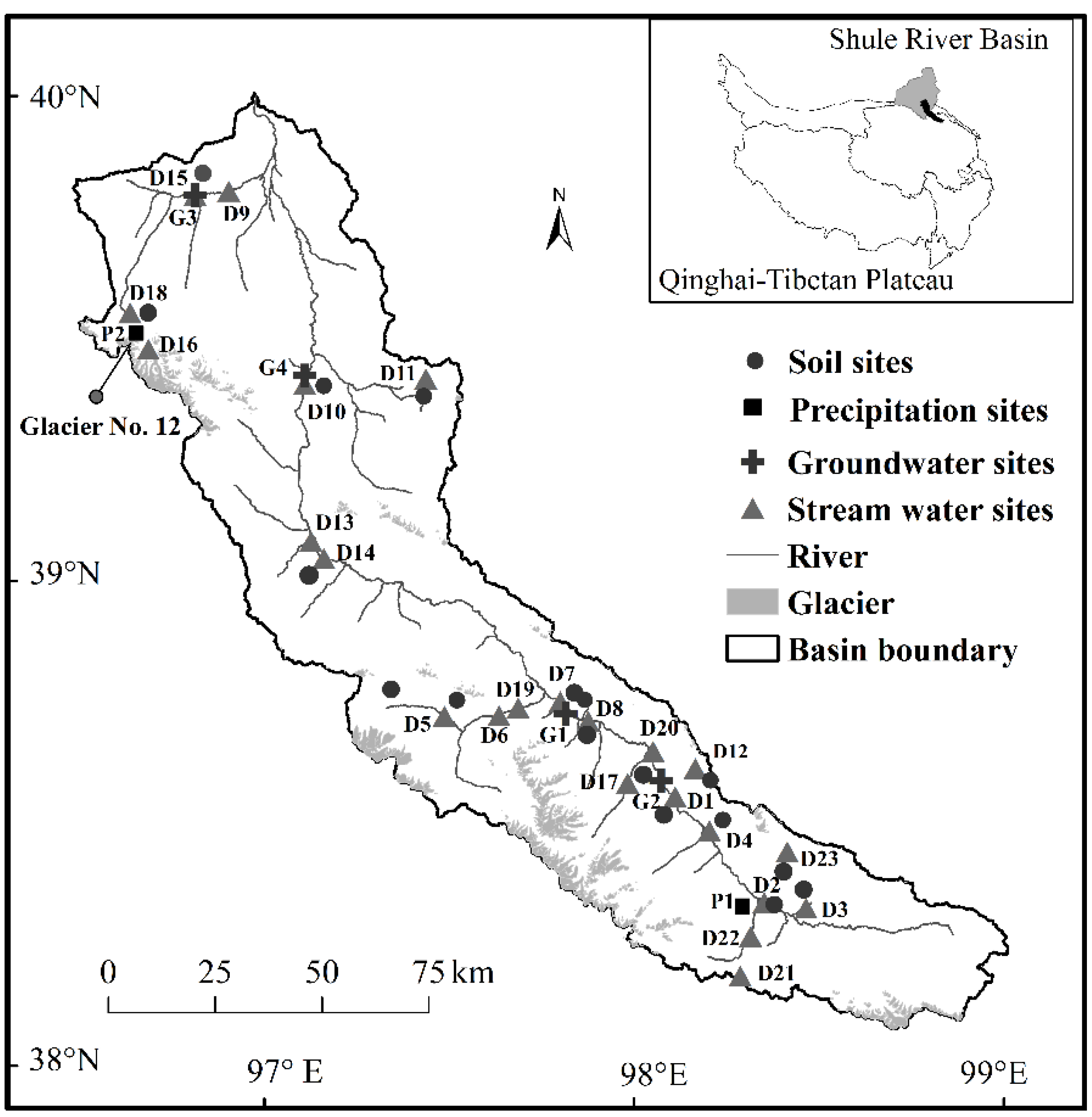
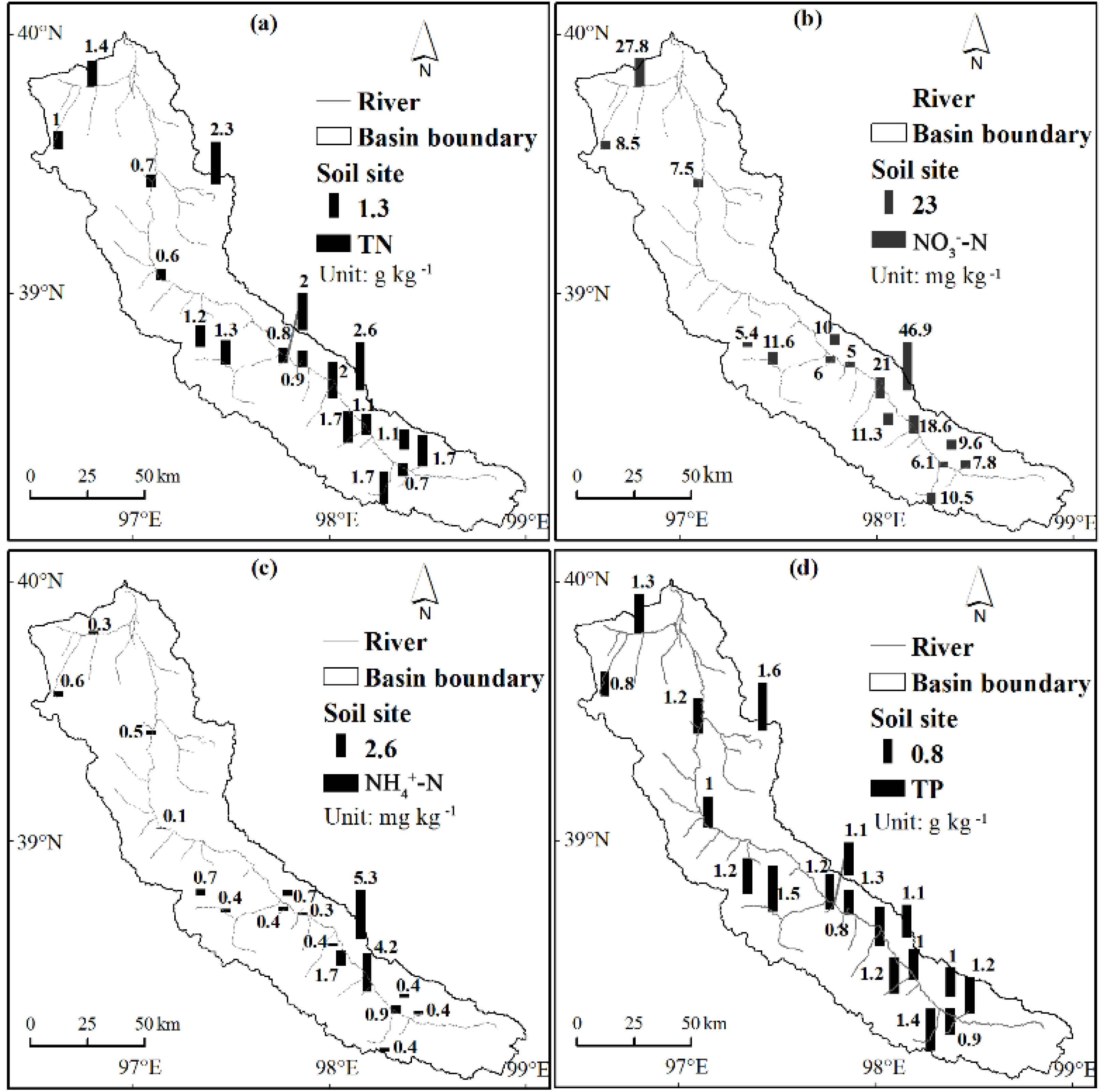
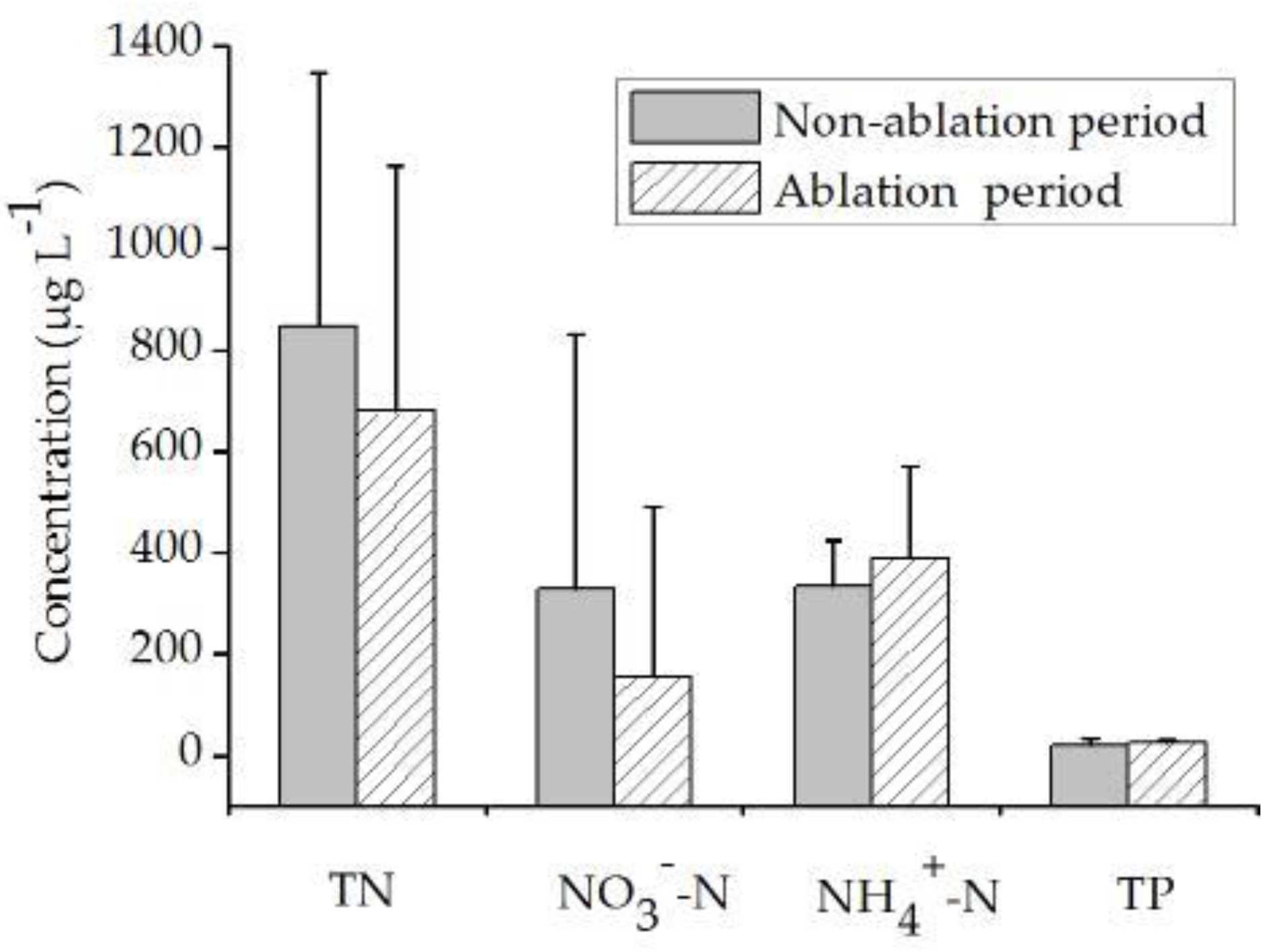

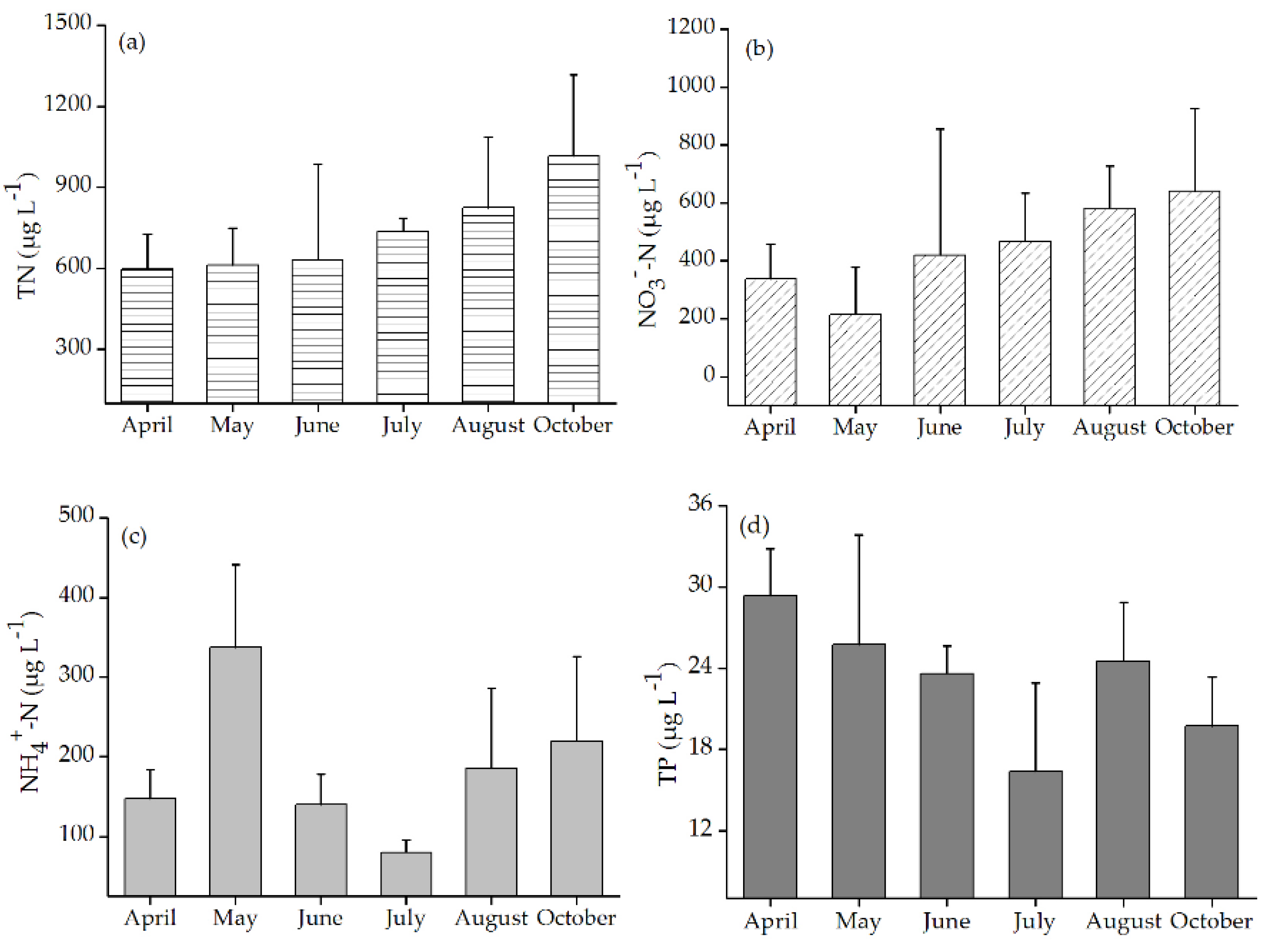
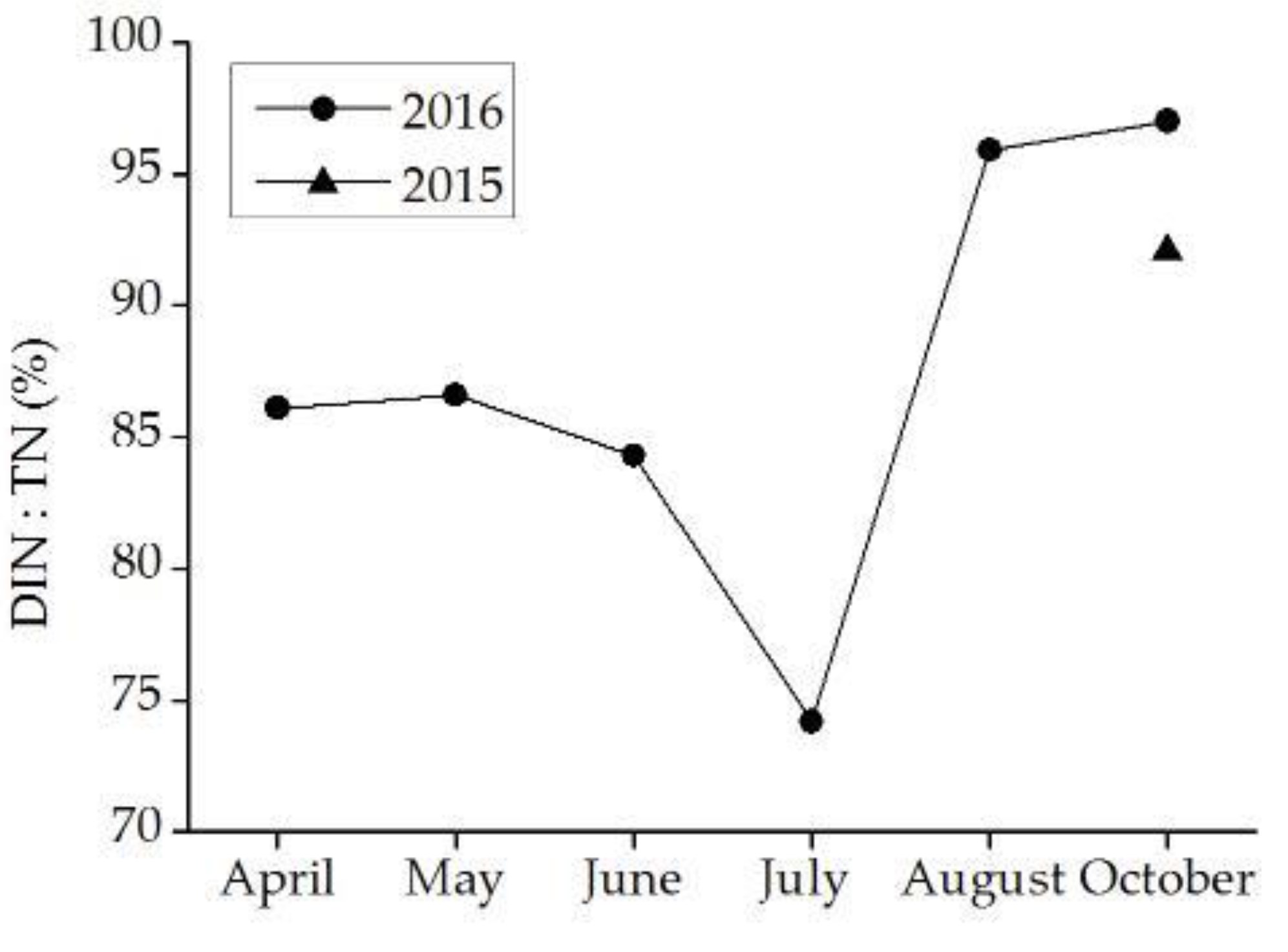
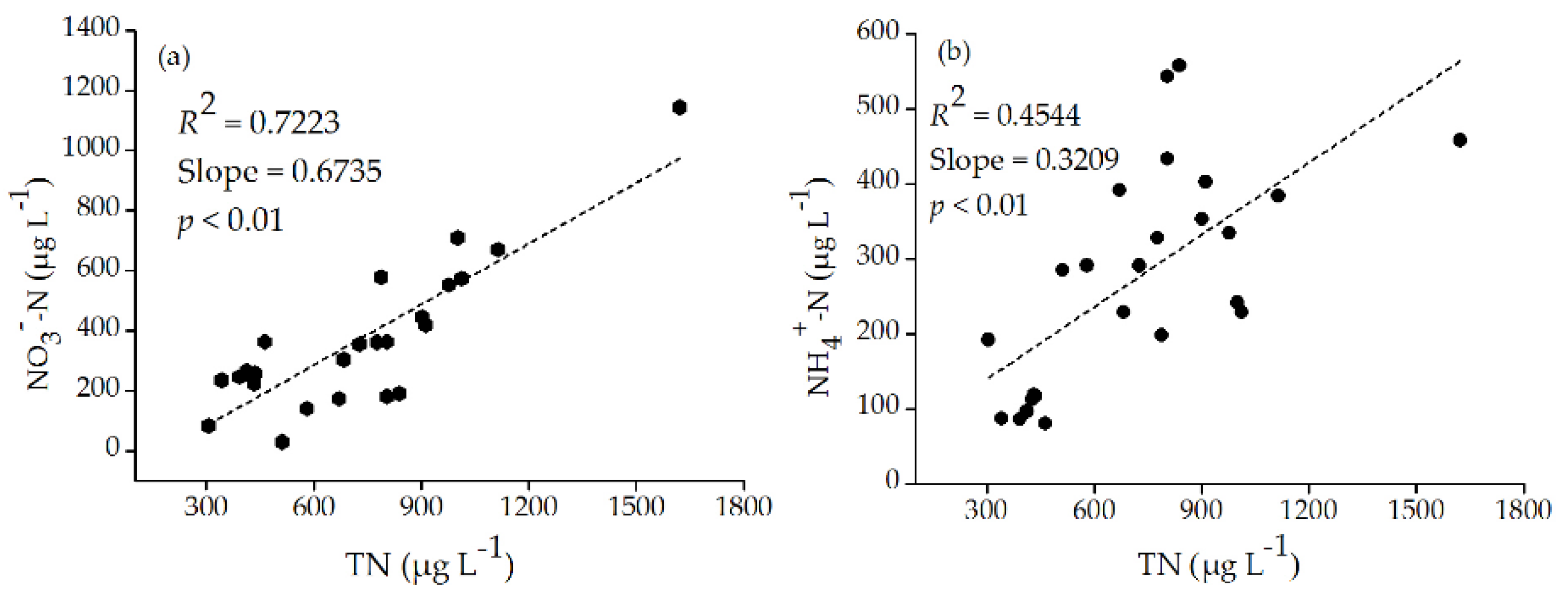

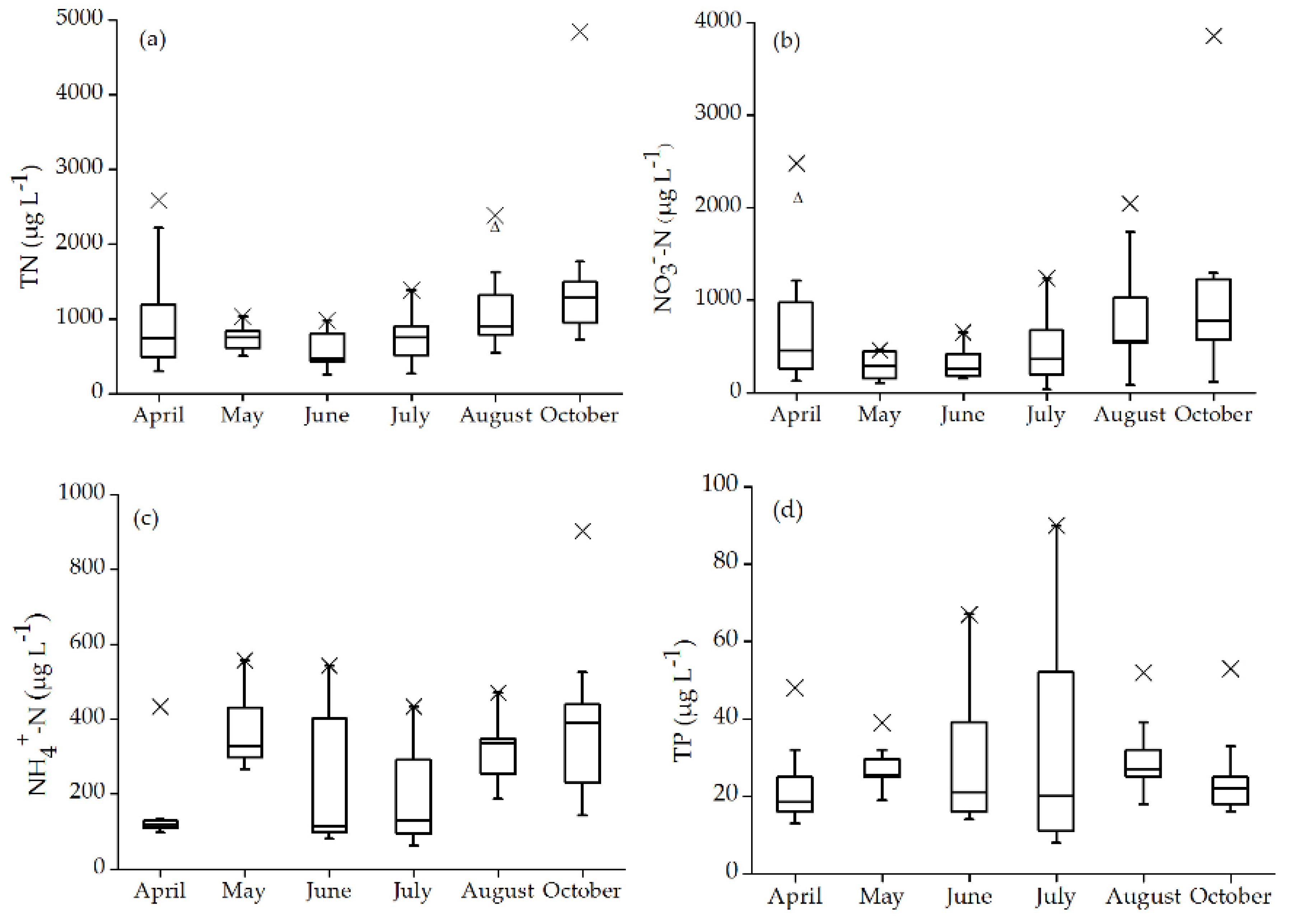
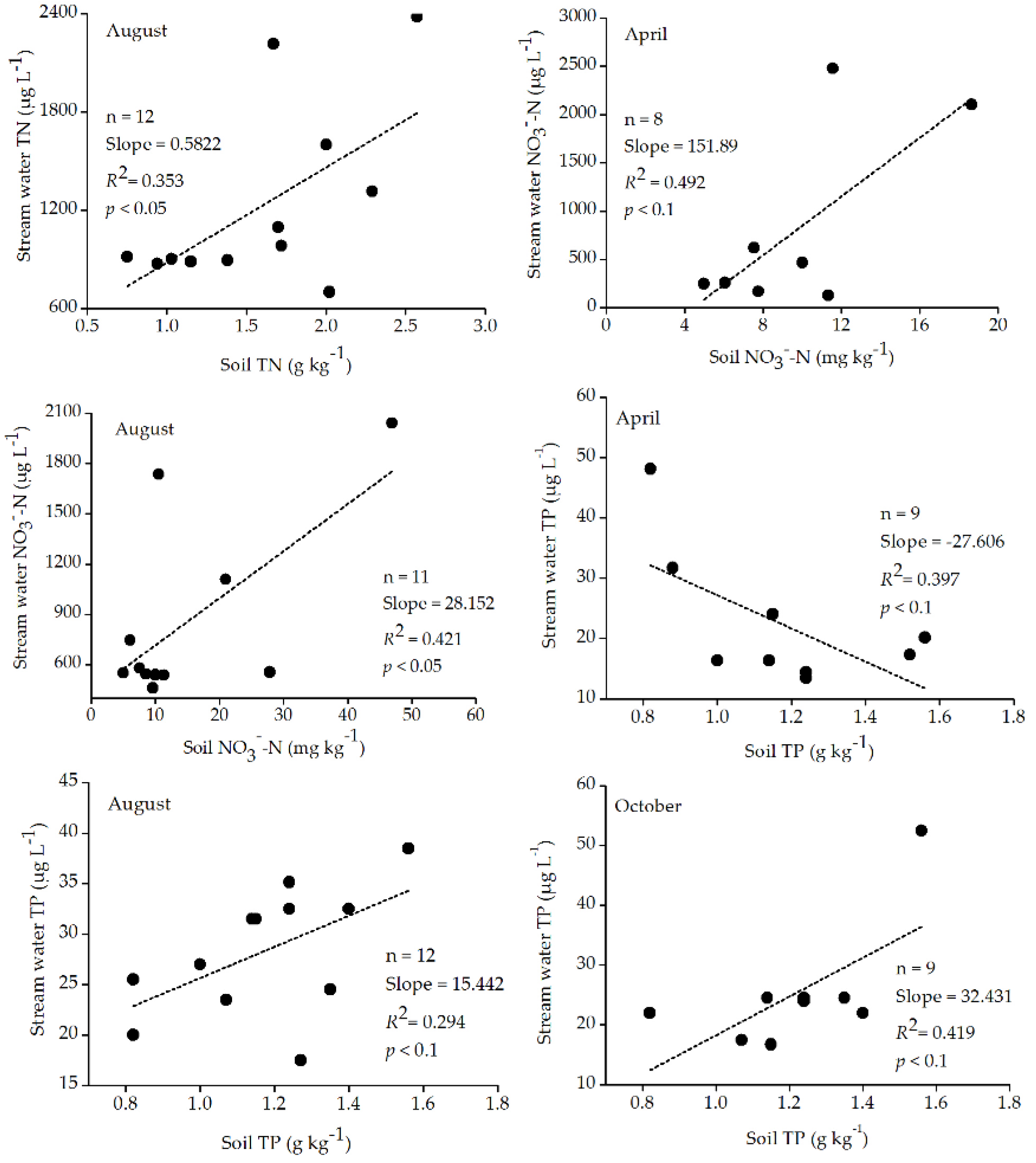


| Sample Type | Number of Samples | Sampling Time | Analyzed Species |
|---|---|---|---|
| Stream water | 88 | 23/4/2016–17/10/2016 | TN, TP, NO3−-N and NH4+-N |
| Groundwater | 20 | 23/4/2016–17/10/2016 | TN, TP, NO3−-N and NH4+-N |
| Groundwater | 3 | October 2015 | TN, TP, NO3−-N and NH4+-N |
| Rainfall | 24 | 5/7/2016–3/8/2016 | NO3−-N and NH4+-N |
| Surface snow | 31 | January–September 2015 | TN, TP, NO3−-N and NH4+-N |
| Soil | 18 | April–May 2016 | Soil mechanical composition (SMC) and nutrients |
| SOC | STN | STP | STC | NH4+-N | NO3−-N | Altitude | |
|---|---|---|---|---|---|---|---|
| N = 18 | |||||||
| SOC | 1 | ||||||
| STN | 0.954 ** | 1 | |||||
| STP | 0.442 | 0.496 * | 1 | ||||
| STC | 0.322 | 0.442 | 0.257 | 1 | |||
| NH4+-N | 0.483 * | 0.446 | −0.199 | 0.189 | 1 | ||
| NO3−-N | 0.715 ** | 0.708 ** | 0.167 | 0.536 * | 0.717 ** | 1 | |
| Altitude | 0.334 | 0.249 | −0.128 | −0.476 * | 0.289 | 0.042 | 1 |
| Sample Type | TN | NO3−-N | NH4+-N | TP |
|---|---|---|---|---|
| μg L−1 | μg L−1 | μg L−1 | μg L−1 | |
| Surface snow | 800 ± 491 | 305 ± 439 | 377 ± 145 | 26 ± 9 |
| Rainfall | 1490 ± 1517 | 45 ± 49 | ||
| Groundwater | 746 ± 257 | 511 ± 261 | 176 ± 107 | 25 ± 6 |
| Stream water (D2) | 726 ± 327 | 303 ± 287 | 284 ± 140 | 32 ± 20 |
| Stream water | 815 ± 623 | 459 ± 582 | 253 ± 152 | 25 ± 16 |
© 2018 by the authors. Licensee MDPI, Basel, Switzerland. This article is an open access article distributed under the terms and conditions of the Creative Commons Attribution (CC BY) license (http://creativecommons.org/licenses/by/4.0/).
Share and Cite
Pu, H.; Ding, Y.; Han, T.; Liu, F. Spatiotemporal Variation of Nutrient Concentrations in the Upper Shule River Basin, the Qinghai-Tibetan Plateau, China. Water 2018, 10, 366. https://doi.org/10.3390/w10040366
Pu H, Ding Y, Han T, Liu F. Spatiotemporal Variation of Nutrient Concentrations in the Upper Shule River Basin, the Qinghai-Tibetan Plateau, China. Water. 2018; 10(4):366. https://doi.org/10.3390/w10040366
Chicago/Turabian StylePu, Hongzheng, Yongjian Ding, Tianding Han, and Fengjing Liu. 2018. "Spatiotemporal Variation of Nutrient Concentrations in the Upper Shule River Basin, the Qinghai-Tibetan Plateau, China" Water 10, no. 4: 366. https://doi.org/10.3390/w10040366




